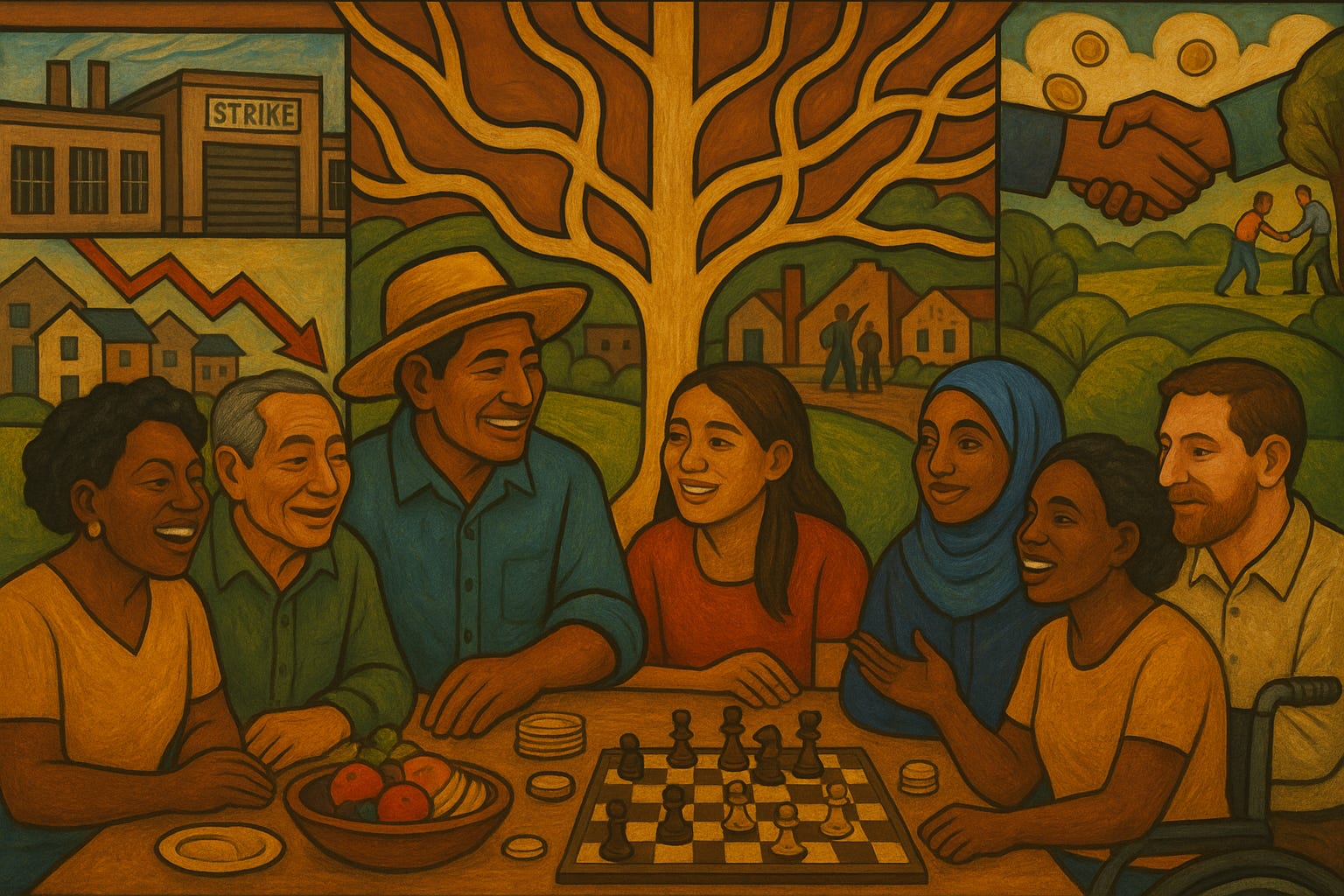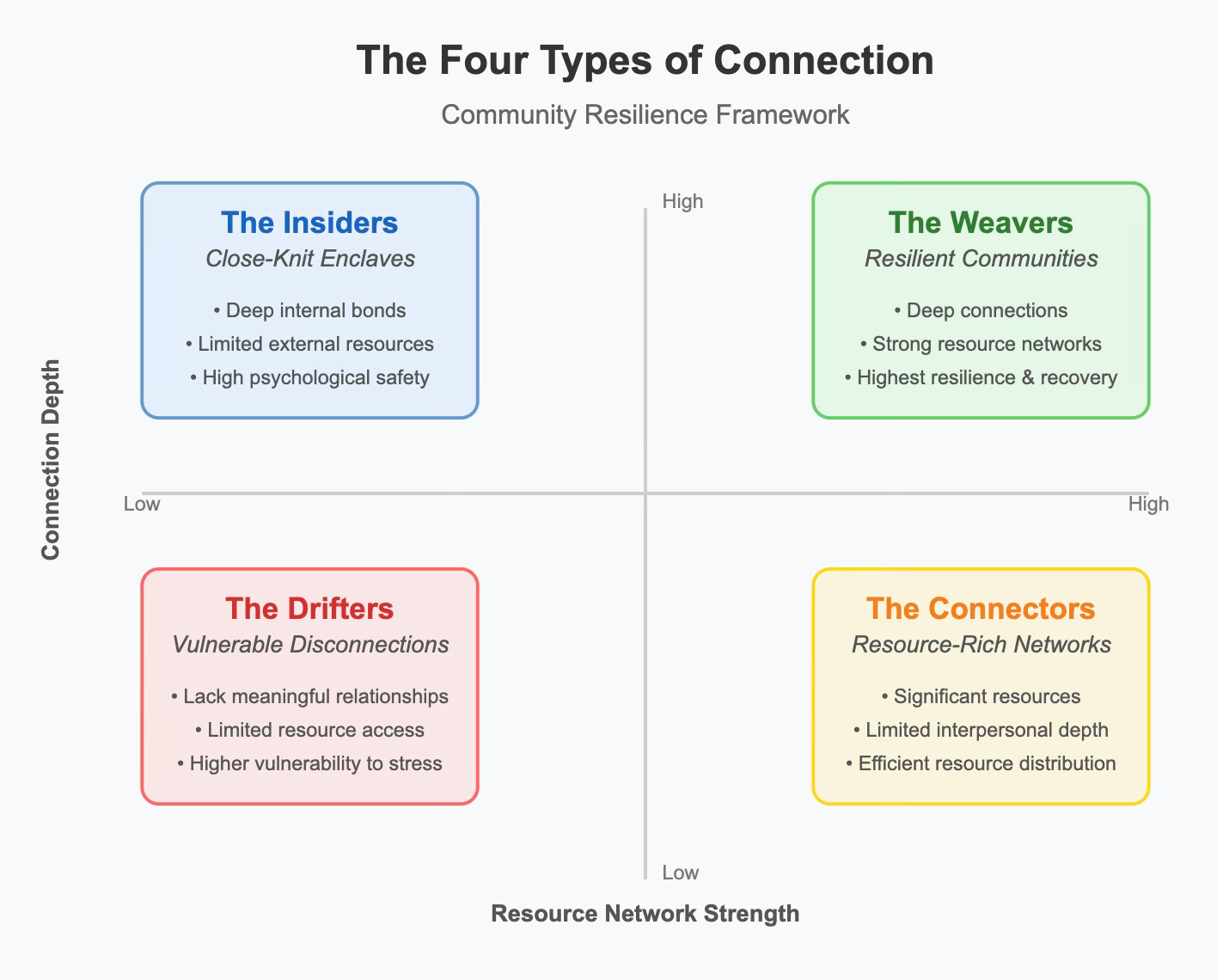Foundations: The Surprising Science of Connection
Think solving tiny crossword puzzles is the secret to flourishing? Think again.
Science reveals a surprising truth: your relationships can help you to flourish much more than brain teasers. While Wordle gives your mind a momentary workout, a spontaneous conversation with your neighbor activates neural pathways we’ve systemically underestimated.
What if the strongest predictor of cognitive resilience isn’t what you do alone, but how you connect with others?
The Hidden Story Inside This Week’s Headlines
Tariffs, memecoins, Musk, and the market — all telling the same story: concentration, polarization, and magical thinking.
Trump 2.0. A 10% blanket tariff is a tax on every household. Wall Street smells stagflation already: UPS pink-slipped 20,000 workers, and GM froze its forecast until Washington hands it a rulebook.
RFK Jr. at HHS. The anti-vax evangelist now runs the nation’s immune system on dial-up speed. He’s cut one-in-five FDA scientists while measles and bird-flu cases climb.
Memecoin mania. $4 billion in vaporized paper wealth in 48 hours; DOGE off 6 % as North Korea’s Lazarus Group skims the hype.
Musk’s messy quarter. Tesla deliveries –20%, profit –71%, and showrooms are tagged by protesters. Meanwhile X is an open firehose of disinfo on both sides of the border.
The “Magnificent 7.” Down 16% in Q1. When seven major stocks sneeze, every 401(k) catches the flu—the narrowest market in a generation just reminded us why diversification isn’t just for TED talks; it’s a survival strategy.
Five headlines, one pattern: we’ve outsourced resilience to the very forces eroding it.
Adaptive Resilience isn’t just built by individuals—it’s woven through systems. When trade wars slash jobs and local spending, or mass-deportation politics fracture communities, we lose more than income—we lose trust. When algorithms amplify misinformation instead of insight, and memecoins evaporate wealth meant for real-world connection, anxiety rises and participation drops. Add in Tesla layoffs gutting regional economies and the Mag-7’s market grip undermining financial resilience, and you see the full picture:
When we don’t invest in social capital—shared meaning, trust, safety, and support—we break the very net that could catch us.
Your Social Network Is Your Neural Network
Researchers pooled data from over 38,000 participants and discovered that people who lived with others, caught up weekly with friends, or joined community groups all experienced slower declines in memory and thinking skills. Even more striking? Simply “never feeling lonely” was linked to better cognitive health—regardless of network size1.
This flies in the face of our productivity-obsessed culture. We buy brain-training apps, schedule meditation sessions, and meticulously track our sleep—all solo activities—while neglecting the cognitive superpower hiding in plain sight: other people.
Reality check: Your $4.99 brain training app might feel productive, but your neighbor's barbecue invitation is what really helps you flourish.
Your Brain’s Hidden Resilience Switch
Your brain doesn’t just enjoy social connection—it requires it. When neuroscientists map brain activity during social interactions, they don’t see a mild response. They see fireworks.
Think of social connection as operating across four dimensions that build resilience:
Cognitive Stimulation: Your friend’s unexpected perspective on a problem isn’t just interesting—it’s rewiring your neural pathways. When you navigate social environments, you exercise the same networks that help you adapt to change and uncertainty. That casual coffee chat isn’t just pleasant—it’s cross-training for your brain.
Psychological Safety: We know stress damages brain health. What’s the antidote? Research consistently shows that strong social connections create measurable reductions in stress hormones like cortisol. Each meaningful interaction builds what psychologists call “psychological flexibility”—your ability to remain present and adaptive even amid disruption.
Resource Networks: Your friend who knows ChatGPT, your neighbor with a generator, your colleague with a connection to that job opportunity—these aren’t just conveniences. Communities with strong social capital consistently survive crises better. One study found that neighborhoods with resilience centers providing both emergency support and year-round community building showed significantly stronger recovery from environmental emergencies2.
Meaning Generation: Perhaps most powerfully, social connection rewrites how we interpret challenges. Neuropsychologists like Jetten and colleagues3 have shown that belonging to meaningful groups fundamentally changes how our brains categorize threats, creating cognitive flexibility that isolated individuals simply cannot access.
The Four Types of Connection
Not all social connections are created equal. Based on decades of research, we can map four distinct community types.
The Drifters: These Vulnerable Disconnections lack both meaningful relationships and resource access. They show higher vulnerability to stressors and poorer health outcomes. Recent Census Bureau data shows these populations experience significantly higher vulnerability during climate emergencies4.
The Insiders: These Close-Knit Enclaves develop deep bonds but limited external resources. They excel at psychological safety but may struggle when crises require external support. Think of close cultural communities where members deeply support each other but have limited connections to outside resources.
The Connectors: These Resource-Rich Networks have access to significant resources but limited interpersonal depth. They’re efficient at distributing material resources but lack the psychological safety benefits of deeper connection. Think of wealthy neighborhoods where residents have resources but rarely interact meaningfully.
The Weavers: These are Resilient Communities that combine deep connections with strong resource networks. They experience the highest cognitive enhancement benefits and best crisis recovery. Think of neighborhoods with strong community centers where people both know each other’s names and coordinate resource sharing during emergencies.
Fostering both deep connections and robust resource networks creates optimal resilience. The good news? You can intentionally move toward the “Weaver” quadrant with surprisingly simple practices.
Connection by Design, Not Default
If social connection is so powerful, why don’t we prioritize it? Because we’ve designed our environments to work against our social neurobiology, not with it.
Environment as Interface: Putnam’s5 groundbreaking research established that “third places”—locations beyond home and work where connections naturally form—are critical for community resilience. What looks like casual chatting at the corner cafe is actually a sophisticated social infrastructure with measurable health impacts.
Perspective Integration as Practice: Want to boost collective intelligence? A meta-analysis by Woolley and colleagues6 found that diverse teams with healthy social dynamics consistently outperform even brilliant individuals working alone. The secret isn’t in IQ but “social sensitivity”—the ability to read and respond to others.
Connection as Daily Practice: Longitudinal research shows that regular social activities predict stability in well-being measures, even during health challenges7.
So don’t only put a dinner party on the calendar—design it.
The New Infrastructure
The emerging consensus across disciplines is clear: social connection isn’t a luxury—it’s essential infrastructure. A comprehensive review published in World Psychiatry by Wehrli and colleagues8 concluded that “robust evidence documents social connection factors as independent predictors of mental and physical health, with some of the strongest evidence on mortality.”
Yet our institutions still treat connection as optional. We invest billions in physical infrastructure but underinvest in the social systems that determine whether communities thrive or collapse during challenges. California’s recent $93 million investment in community resilience centers represents a shift toward recognizing connection as critical infrastructure9.
The science is clear: we are not designed for self-sufficiency. Our brains developed in groups, and they still function best in connection. Every conversation, community gathering, and act of mutual aid isn’t just socially satisfying—it’s biologically essential.
As you consider your personal resilience strategy, ask yourself: Am I investing as much in my relationships as I am in my retirement account?
The returns might be more valuable than you realized.
How to Write Your Own Story
We’ve explored how the science overwhelmingly confirms what many of us intuitively sense, but reject because of the status quo: our relationships form the neural scaffolding for our cognitive resilience.
Clarity, Strength, Flow, and Connection are the pillars of Adaptive Resilience. Together they form to a blueprint on how to flourish.
Next week, we’ll shift from what the pillars are to how to put it all in action. In a world of increasing complexity and accelerating change, our capacity to do represents an incredible frontier.
By writing your own story, Adaptive Resilience comes to life.
Evans, I. E. M., et al. (2022). Associations between social connections and cognition: a global collaborative individual participant data meta-analysis. Lancet Healthy Longevity, 3(11), e740–e753.
Greenlining. (2024, January 30). What's all the hub about? How community resilience hubs can bridge gaps in social connection, wellness and transportation.
Jetten, J., Haslam, C., & Haslam, S. A. (Eds.). (2012). The social cure: Identity, health and well-being. Psychology Press.
U.S. Census Bureau. (2024, July 16). Census Bureau releases update to Community Resilience Estimates for Heat.
Putnam, R. D. (2000). Bowling alone: The collapse and revival of American community. Simon & Schuster.
Woolley, A. W., et al. (2015). Evidence for a collective intelligence factor in the performance of human groups. Science, 330(6004), 686-688.
Sharifian, N., & Grühn, D. (2019). The differential impact of social participation and social support on psychological well-being: Evidence from the Wisconsin Longitudinal Study. The International Journal of Aging and Human Development, 88(2), 107-126.
Wehrli, S., Holt-Lunstad, J., et al. (2024). Social connection as a critical factor for mental and physical health: evidence, trends, challenges, and future implications. World Psychiatry, 23(3), 312-332.
Strategic Growth Council. (2024, April 24). Press release: Vulnerable communities to receive $98.6M in grants to build climate resiliency.



